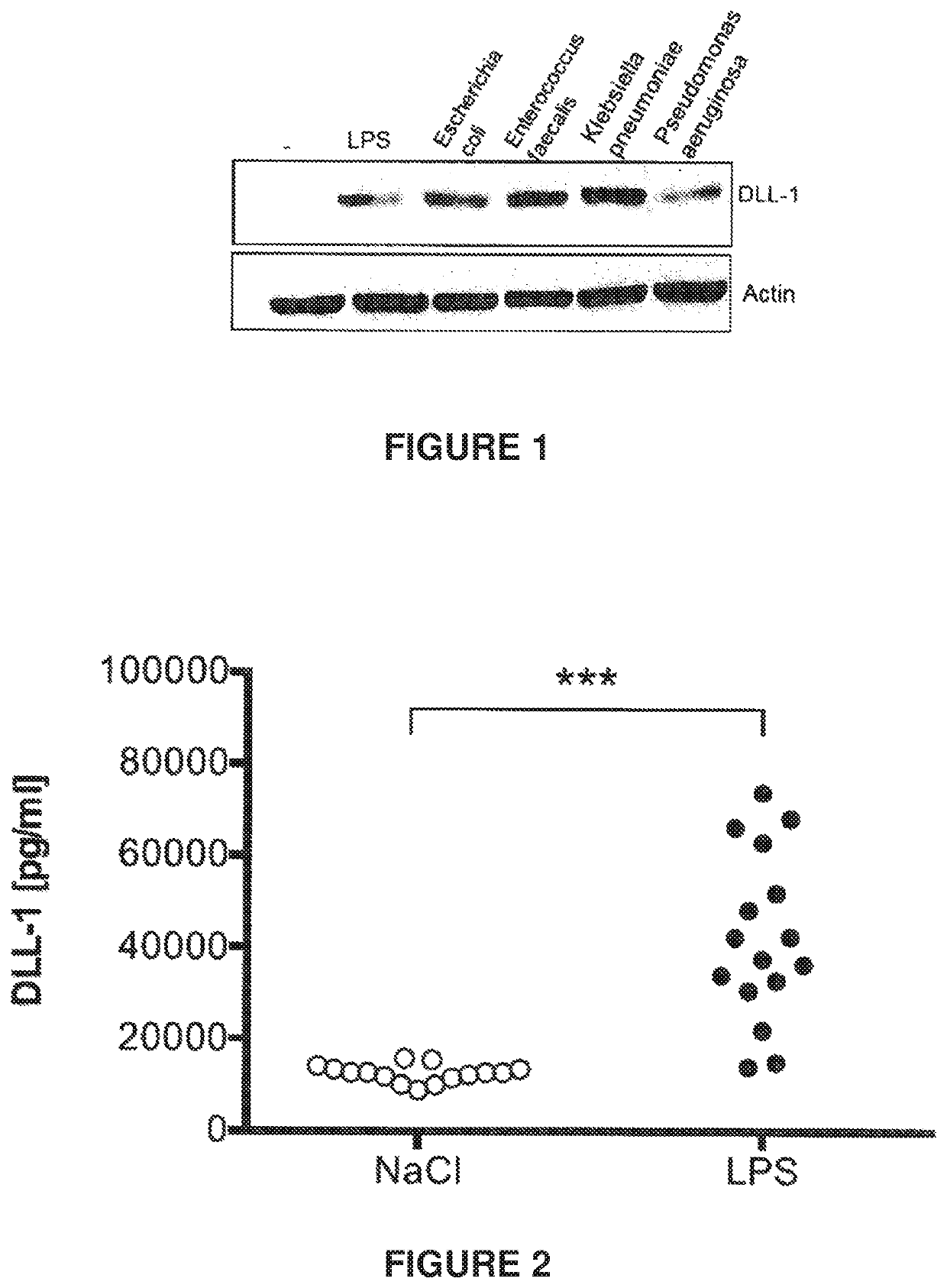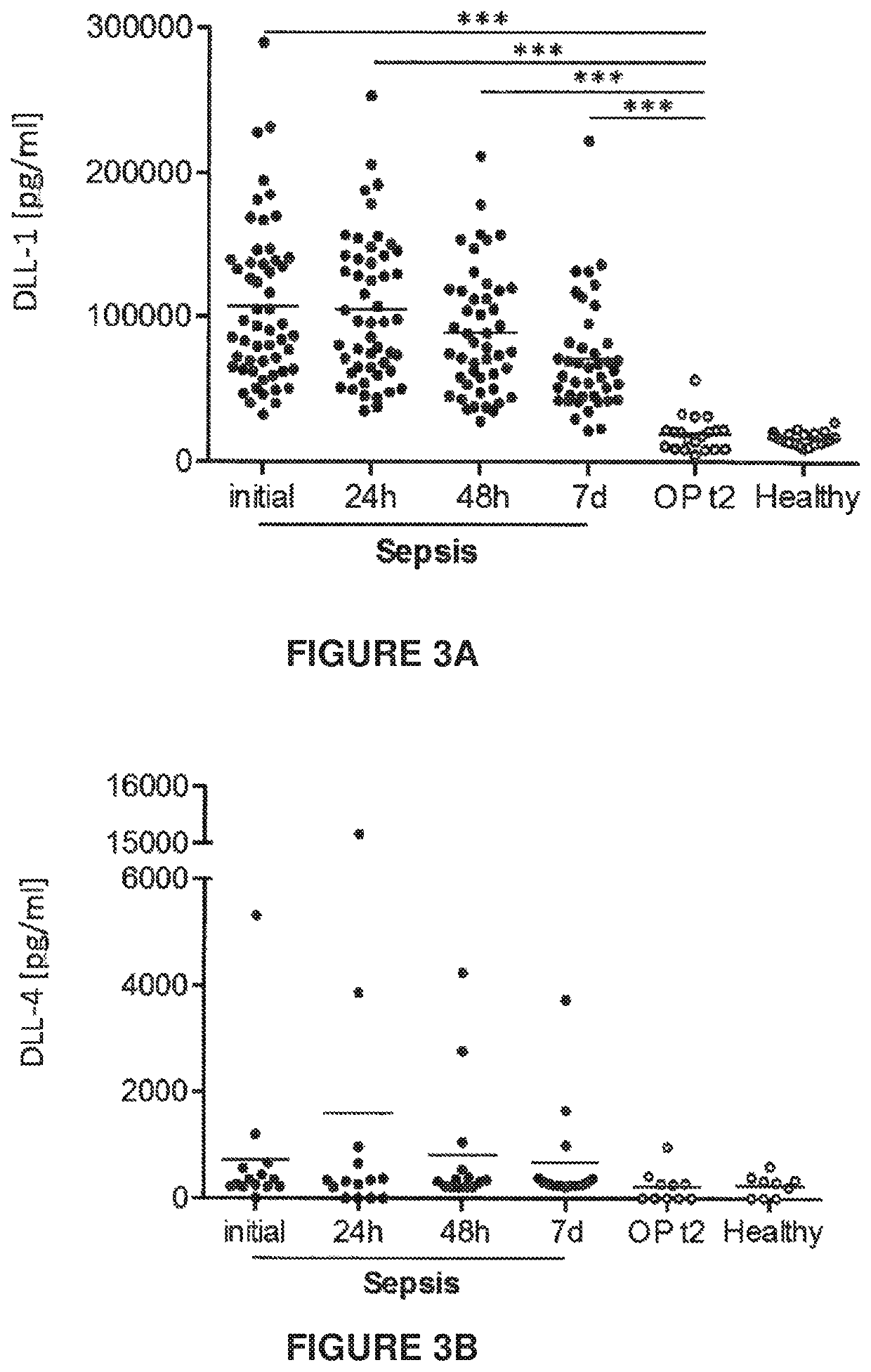Delta-like ligand 1 for diagnosing severe infections
a technology of severe infections and delta-like ligands, applied in biochemistry apparatuses, instruments, peptide sources, etc., can solve the problems of life-threatening organ failure, severe sepsis, and infection as a leading cause of death in intensive care units across all, and achieve high reliability
- Summary
- Abstract
- Description
- Claims
- Application Information
AI Technical Summary
Benefits of technology
Problems solved by technology
Method used
Image
Examples
example 1
Delta-Like Ligand 1 Detects Bacterial Infection In Vitro
[0049]This example checked whether the Notch ligand DLL1 could be upregulated in sepsis patients and therefore could be used as a potential biomarker. An in vitro infection model with sepsis-relevant bacteria was used. In the experimental setup blood-derived monocytes from healthy donors was infected for two hours with different gram negative (Escherichia coli, Pseudomonas aeruginosa, Klebsiella pneumoniae) and gram positive bacteria (Enterococcus faecalis) and subsequently bacteria was killed with antibiotics. Furthermore cells were stimulated with TLR4 agonist lipopolysaccharide (LPS), a component of gram negative cell wall which can cause septic shock when circulating in the blood stream. After overnight incubation of infected and LPS-stimulated cells lysates were produced for western blot analysis for the detection of DLL1. The experimental details are explained below.
[0050]Cell Isolation and Culture
[0051]Peripheral blood-d...
example 2
Delta-Like Ligand 1 is Upregulated in a Mouse Sepsis Model
[0060]As it was seen that activated DLL1 is highly abundant in in vitro bacterial infected monocytes, behaviour of the Notch ligand was examined in a mouse endotoxin sepsis model. LPS (precisely the lipid part of LPS) is also termed endotoxin and commonly used in animal models of sepsis. In critically ill patients, increased concentrations of serum endotoxin have been associated with the development of sepsis, disease severity, and mortality. The theory that endotoxin plays a significant role in the pathogenesis of human sepsis is supported by the observation that antibiotic therapy can lead to a sudden release of massive amounts of endotoxin from dead bacteria and a worsening of the condition. Here 12 weeks old male mice were used for experimental purposes.
[0061]Twelve-week old male mice were injected intraperitoneally with either the lipid portion of LPS (n=16) or NaCl (n=15; as a control). After 24 hours, blood was drawn. ...
example 3
Delta-Like Ligand 1 is Upregulated in Sepsis Patients
[0063]50 patients were included in the study, all of whom showed signs of severe sepsis following abdominal surgery. Sepsis was defined according to the criteria of the Surviving Sepsis Campaign. Only non-pregnant patients of at least 18 years were included. Further exclusion criteria included autoimmune diseases. After inclusion, blood samples were drawn from septic patients directly following identification of the first signs of sepsis (“t0”), after 24 hours (“t24”), 48 hours (“t48”), and 168 hours (“t168”).
[0064]20 control patients who had undergone abdominal surgery but presented no signs of sepsis (“OP t2”) had their blood drawn 48 hours following surgery. 20 healthy volunteers (“healthy”) were recruited as non-operated controls and had their blood drawn once.
[0065]Blood plasma was analyzed for the levels of human delta-like ligand 1 protein and additionally human delta-like ligand 4 protein using commercial ELISA assays (DLL...
PUM
| Property | Measurement | Unit |
|---|---|---|
| time | aaaaa | aaaaa |
| time | aaaaa | aaaaa |
| concentrations | aaaaa | aaaaa |
Abstract
Description
Claims
Application Information
 Login to View More
Login to View More - R&D
- Intellectual Property
- Life Sciences
- Materials
- Tech Scout
- Unparalleled Data Quality
- Higher Quality Content
- 60% Fewer Hallucinations
Browse by: Latest US Patents, China's latest patents, Technical Efficacy Thesaurus, Application Domain, Technology Topic, Popular Technical Reports.
© 2025 PatSnap. All rights reserved.Legal|Privacy policy|Modern Slavery Act Transparency Statement|Sitemap|About US| Contact US: help@patsnap.com



